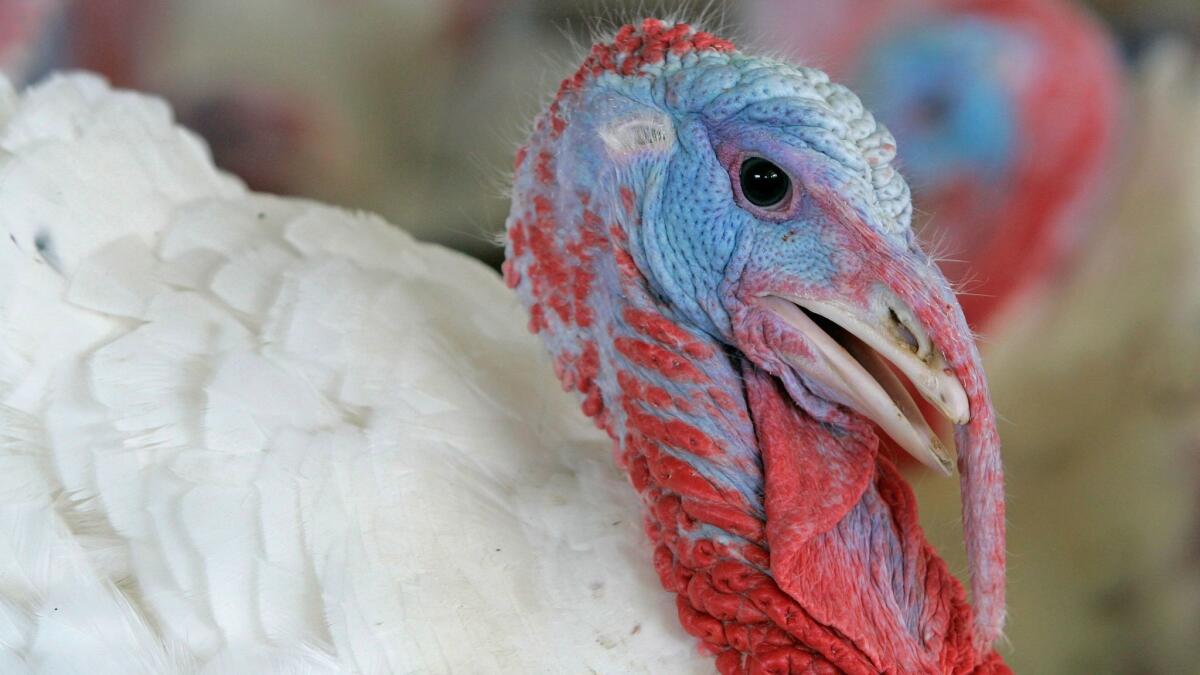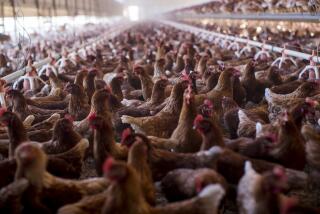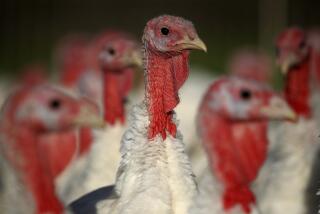Editorial: There’s a grim reality behind your Thanksgiving turkey

Observing an annual pre-Thanksgiving rite, President Trump pardoned two big white fluffy turkeys Tuesday in a photo op at the White House. (Named Drumstick and Wishbone, the birds will end up at an enclosure on the campus of Virginia Tech.) That leaves 46 million other turkeys that won’t get pardoned. Instead, they’ll wind up on someone’s dinner table during this holiday season, a fate that is expected to befall about 245 million gobblers all told this year. And none of them will make the journey from farm to table via the Willard InterContinental Hotel, where Drumstick and Wishbone hung out before Drumstick was ceremoniously presented to Trump.
No animals raised on factory farms are kept and killed under worse conditions than turkeys and chickens, which make up most of the animals raised for food in the U.S. Nearly 9 billion chickens are slaughtered each year for food. And because poultry is exempt from the federal Humane Methods of Slaughter Act, which the U.S. Department of Agriculture enforces, there are not even minimum federal standards governing how they live or die.
Turkeys and so-called broiler chickens are genetically bred to grow fast (to satisfy our love for breast meat) and, typically, grow so big that they can barely walk by the time they are killed. As a result, they can suffer from painful skeletal disorders and leg deformities. The vast majority spend their short lives (about 47 days for chickens) in artificially lit, windowless, barren warehouse barns. So that turkeys won’t peck one another in these crowded barns, their beaks are painfully trimmed.
There are the grim realities behind Americans’ traditional Thanksgiving meal.
When it’s time to slaughter them, the live birds are shackled upside down on a conveyor belt, paralyzed by electrified water and then dragged over mechanical throat-cutting blades. The birds are supposed to be stunned unconscious by the electrified water, but that doesn’t always happen. Sometimes the birds miss the blades and end up tumbling into the tanks of scalding water, where they drown. These methods are so cruel that they would be prohibited by federal welfare laws — if the animals in question were cows or pigs.
These are the grim realities behind Americans’ traditional Thanksgiving meal. But there are ways to make life and death somewhat better for the turkeys that wind up on your table. Of course, we could all just eat less turkey and chicken, which would reduce the demand for these animals. But to make a bigger impact, the major buyers of chicken and turkey meat need to push their suppliers to adopt less grisly practices.
The Humane Society of the U.S. has launched a campaign to get producers to pledge to raise healthier, less bloated birds, to provide them with better living conditions — more space, more stimulating environments and more sunlight — and, perhaps most important, to render the birds unconscious before they are shackled and slaughtered. The campaign also seeks to persuade buyers to obtain meat only from producers that honor this pledge. Meanwhile, Temple Grandin, the animal science professor known for designing more humane procedures for slaughtering beef cattle, has called for “controlled atmosphere stunning,” a process of using gas to make the birds unconscious before they get shackled for slaughter.
Just as pressure from animal welfare advocates, consumers and California voters led poultry farmers to free egg-laying hens from tiny cages, industry is now responding to similar pressure to implement more humane conditions for turkeys and broiler chickens. Whole Foods announced last year that it would begin to replace meat from fast-growing chickens with products from slower-growing breeds that are given more space. Perdue Farms Inc., a major chicken producer, has changed some of its plants and has incorporated gas stunning at its turkey plant in Indiana. And nearly 70 companies have signed on to the Humane Society’s campaign, including Burger King, Subway, Aramark and Panera. Many of these companies have put out new policy statements of commitment to obtaining poultry only from producers that raise smaller chickens and render them unconscious before shackling them.
Installing new procedures takes time and money. All the buyers and producers that have signed on to the Humane Society campaign have agreed to fully convert to a new system by 2024. Companies should be held to that time frame, and more should be encouraged to take that pledge. If enough consumers demand it, companies will do it. That’s not too much to ask for the sake of the bird you’ll be carving up on Thanksgiving.
Follow the Opinion section on Twitter @latimesopinion or Facebook
More to Read
A cure for the common opinion
Get thought-provoking perspectives with our weekly newsletter.
You may occasionally receive promotional content from the Los Angeles Times.










